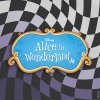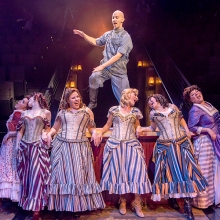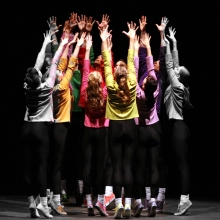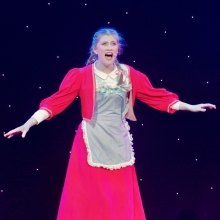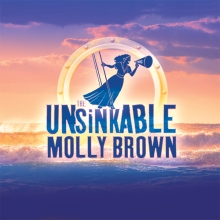Filichia Features: WHERE’S CHARLEY? He’s Here!

Filichia Features: WHERE’S CHARLEY? He’s Here!
Seventy years ago last week, Where's Charley? became the first audience participation musical.
It wasn't planned that way, as Holly Van Leuven tells us in Ray Bolger: More Than a Scarecrow, her new biography courtesy of Oxford University Press.
On the first Saturday matinee, Bolger lost his way during Frank Loesser's "Once in Love with Amy."
Luckily, someone in the audience could cue him: Bobby Feuer, all of seven years old. Because his father Cy was co-producing the show, the lad had repeatedly heard the song at home through a demo recording.
So the kid chimed in. Bolger then decided to invite the audience to sing along and indeed they did. He continued the practice for the remaining 785 performances.
Thank Bobby's dad, too, for Bolger wouldn't have done Where's Charley? had Cy Feuer not reworked Brandon Thomas' 1892 farce, Charley's Aunt.
Because this was the biggest London hit in the entire 19th century -- 1,466 performances - Thomas' heirs were reluctant to bestow rights to a musical. A flop might damage the reputation of the still-widely produced comedy. (Its legacy continues: The Shakespeare Theatre of New Jersey opens a production next week.)
Thomas' farce concerns Charley and Jack, both Oxford undergrads at the turn of the last century. They're respectively smitten with Amy and Kitty, but in those days, young English couples were cautiously chaperoned, lest they do something untoward.
So the foursome is glad that Charley's aunt from Brazil will arrive to keep decorum. Then alas! She can't make the trip after all.
Young love will not be easily thwarted. The guys entice their friend Lord Babberley to don a dress and impersonate the aunt.
In the late '40s, neophyte producer Ernest Martin came to esteemed theatrical lawyer Howard Reinheimer for advice on making a Broadway musical of An American in Paris.
Mind you, this was years before the 1951 film; Martin simply liked Gershwin's orchestral piece and wanted to build a story around it.
Martin said that he had interest from Bolger which made Reinheimer change the subject and suggest a Charley's Aunt musical for the star.
Then Bolger said that Babberley was too small a part.
Martin's new partner Cy Feuer had a brainstorm. If Charley played the aunt as well, Bolger would have twice as much to do.
In those days, everyone's first choice of director was George Abbott. He said he'd have to see who'd write the score - and waited no longer when the producers signed composer Harold ("Over the Rainbow") Arlen and Frank Loesser, who'd written the lyrics to many hit pop songs and a few as composer and lyricist.
Then Arlen saw his house destroyed by fire, which caused his wife to suffer a nervous breakdown. Arlen withdrew, and Loesser asked to write the entire score. Abbott eventually decided that he'd do.
Did he ever. Loesser soon had the first of his four solid Broadway hits. It remains terrific.
In addition to that sing-along "Amy," Loesser wrote the bouncy "Better Get out of Here" for the young women when they realize they'll have no chaperone. "Make a Miracle" has Charley and Amy predict future wonders: "horseless carriages that fly" and "stereopticons that move." Yes, by 1948 they'd been proved right by airplanes and films, but their boast that "someone bright will cure the common cold" hadn't yet happened - and, for that matter, seven decades later, still hasn't.
Performance styles have changed over the years. Although Bolger was much acclaimed by critics and audiences -- and won a Best Actor in a Musical Tony -- today his interpretation, seen in the 1952 film, shows that his "aunt" walked like a man and overdid the feminine wiles. Truth to tell, even the dimmest dimwit would have seen through the ruse. Such an approach was common then, for it made audiences feel superior for gleaning what characters couldn't.
We're smarter now. The show has enough to entertain without going over the top. So when you stage Where's Charley? encourage your young leading man to act matter-of-factly as a woman and not create a parody of one.
And do cast an actor who can genuinely pass as a college student. Bolger was 44 when he opened the show, 47 when he did the 1951 return engagement and the film - and looked it.
But perhaps what is most required in any Where's Charley? is an actor who can effectively lead an audience into singing "Once in Love with Amy."
You may e-mail Peter at pfilichia@aol.com. Check out his weekly column each Monday at www.broadwayselect.com and Tuesday at www.masterworksbroadway.com . He can be heard most weeks of the year on www.broadwayradio.com.
Share
Callboard
-
Shake and shimmy it with the #Hairspray20Challenge! Join MTI and Broadway Media in celebrating 20 years of #Hairspray. Duet this here or find us on TikTok! Special thanks to @broadwaymedia and @jammyprod. Choreography Guides are a licensor official resource that provides step-by-step instruction from Broadway and professional choreographers for your productions! Visit @broadwaymedia to learn more. #mtishows #youcantstopthebeat #hairspraymusical #goodmorningbaltimore
View on Instagram









